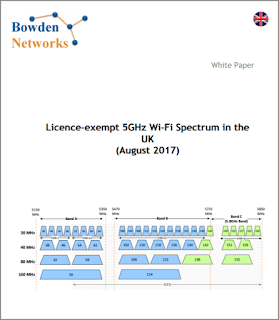Updated White Paper on Licence-Exempt Spectrum in the 5GHz band for Wireless LANs in the UK

For the past few years, I've maintained a white paper on the use of the 5GHz spectrum for Wi-Fi networks here in the UK. As Wi-Fi text books tend to focus on the spectrum available in the USA, I put this document together to clarify how 5GHz spectrum may be used in the UK. Following the release of a Voluntary National Specification document by Ofcom in August 2017 ( VNS 2030/8/3 ), additional channels became available for use in the UK on 5GHz. As we now have additional spectrum, it's time for an update to my white paper to detail the new spectrum that is available. Prior to updating the white paper, I published a summary sheet that shows the new spectrum allocation. This can be obtained obtain from my previous blog article: UK 5GHz WLAN Spectrum Allocation (August 2017) (this is definitely one to print off and laminate). I have now completed my updates to the white paper, which I am pleased to share with you now. Note that in addition to adding the new spectrum det

